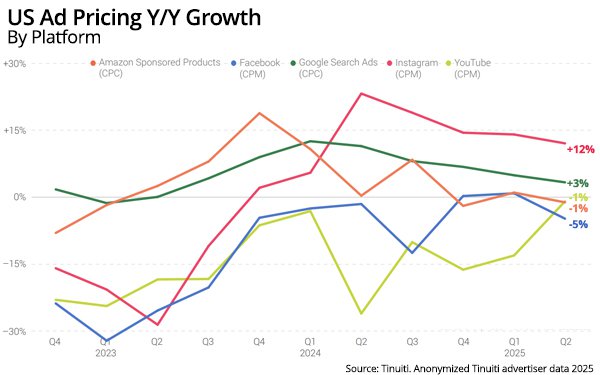Commentary
Google, Amazon Drive Q2 Ad Growth, TikTok Spend Falls 20%
- by Laurie Sullivan , Staff Writer, July 16, 2025

Ad budgets grew in the second quarter of 2025
compared with Q1 across Google paid search, Meta, Amazon Sponsored Products, and YouTube, but TikTok saw ad investments fall as concerns over U.S. tariffs and uncertainty about the future persist.
Tinuiti, a performance agency, released its Digital Ads Benchmark Report for Q2 2025 Wednesday, which explores media buys and performance of digital ads across Google, Meta, Amazon, TikTok and other platforms.
The report is based on anonymized performance data from advertising programs managed by Tinuiti. These companies combined have an annual digital ad spend totaling more than $4 billion.
Spending on Google paid search ads rose 11% year-over-year in Q2 2025, up from 9% growth a quarter earlier. Click growth accelerated to 7% year-over-year, while cost per click (CPC) growth slowed to 3%.
advertisement
advertisement
While year-ago comps for Google were weaker in Q2, Tinuiti clients also saw relatively strong click growth from shopping inventory as some of the strongest competitors for shopping impressions either pulled back on their presence in Google shopping auctions or appeared to withdraw from them entirely.
Click growth jumps across Google paid search and Amazon Sponsored Products. For query-driven ad formats such as Amazon Sponsored Products and Google paid search, ad pricing slowed in the second quarter, and increases in click volume drove spend growth, as economic uncertainty did not appear to dampen consumer search demand.
Spending on Microsoft search ads rose 17% year-over-year in Q2 2025, which matched the results advertisers saw in Q1 2025.
Across text and shopping formats, including Microsoft’s version of Performance Max campaigns, Microsoft paid search clicks were up 15% year over year in Q2, up sharply from 5% growth a quarter earlier. CPC growth, however, decelerated sharply from 11% in Q1 2025 to just 1% in Q2.
While tariffs have directly impacted the amount spent, in aggregate they did not significantly influence ad investment.
Many brands renegotiated contracts and shifted production whenever possible to protect margins and maintain ad budgets. The rollback of the most severe tariffs is part of the reason that ad spend held up.
For example, Tinuiti explains, the 145% rate on Chinese goods was reduced to 30% in May, with a meaningful impact on brands like Shein and Temu that are based in China.
Shein and Temu appeared to pause Google shopping ads entirely in mid-April, likely because of the end of the de minimis exemption, a provision that allows certain low-value shipments to enter a country duty-free and without being subject to most taxes.
Advertisers are not walking away from TikTok, but many are diversifying their social-media investment to other platforms as the fate of the Chinese-owned video app remains in limbo.
Uncertainty around U.S. policies is impacting budgets spent on TikTok. Spend fell 20% during Q2 compared with the year-ago quarter, for median same-store advertiser although 36% of advertisers increased investments year-over-year in Q2, with an average increase among this group of 107%, as some brands continue to lean into TikTok despite the uncertainty
Advertisers are continuing to grow investment in YouTube video campaigns, but also are accessing Google’s video inventory through Demand Gen campaigns, with about half of Demand Gen spend going to video in June.
Demand Gen spend rose 23% year-over-year in Q2, as Google’s April cutoff to create new Video Action Campaigns pushed more spend into Demand Gen.
Another interesting data point, Reddit advertisers spent nearly 10% as much on the platform as they do on Meta. The median advertiser active on Reddit and Meta in Q2 2025 spent 9% as much on Reddit as on Meta for the quarter, while Pinterest and Snapchat advertisers spent 10% and 17% as much as on Meta, respectively.



